light CADILLAC DEVILLE 1995 7.G Owner's Guide
[x] Cancel search | Manufacturer: CADILLAC, Model Year: 1995, Model line: DEVILLE, Model: CADILLAC DEVILLE 1995 7.GPages: 403, PDF Size: 20.69 MB
Page 190 of 403
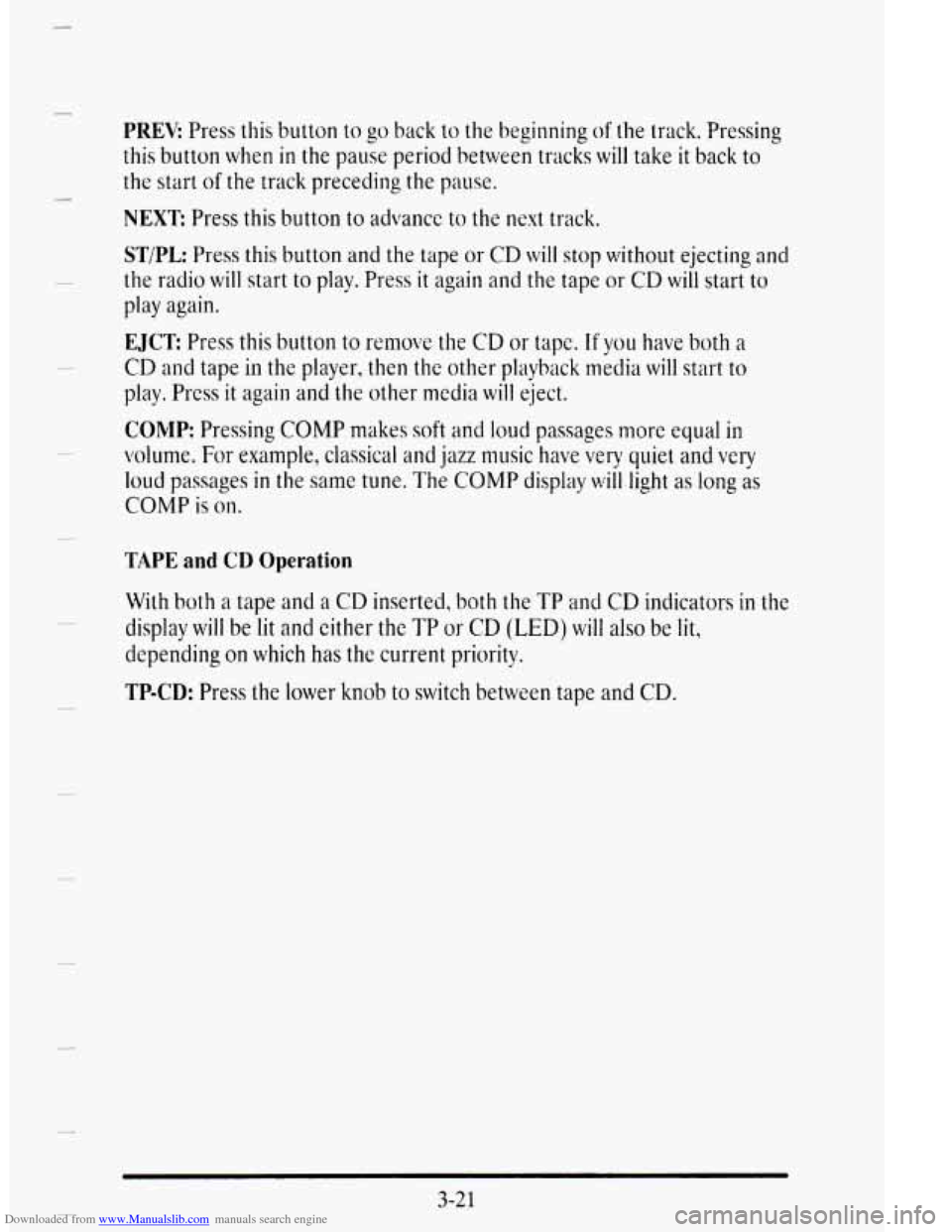
Downloaded from www.Manualslib.com manuals search engine LI
PREY Press this button to go back to the beginning of the track. Pressing
this button
when in the pause period between tracks will take it back to
the start of the track preceding the pause.
NEXT: Press this button to advance to the next track.
ST/PL: Press this button and the tape or CD will stop without ejecting and
the radio will start to play. Press it again and the tape or CD will start to
play again.
EJCT Press this button to remove the CD or tapc. If you nave both a
CD and tape in the player, then the other playback media will start to
play. Press
it again and the other media will eject.
COILIP: Pressing COMP makes soft and loud passages more equal in
volume. For example, classical and jazz music have vety quiet and very
loud passages in the same tune. The COMP display will light as long as
COMP is on.
TAPE and CD Operation
With both a tape and a CD inserted, both the TP and CD indicators in the
display will be lit and either the TP or CD (LED) wjll also be lit,
depending on which has the current priority.
TP-CD: Press the lower knob to switch between tape and CD.
3-21
Page 192 of 403
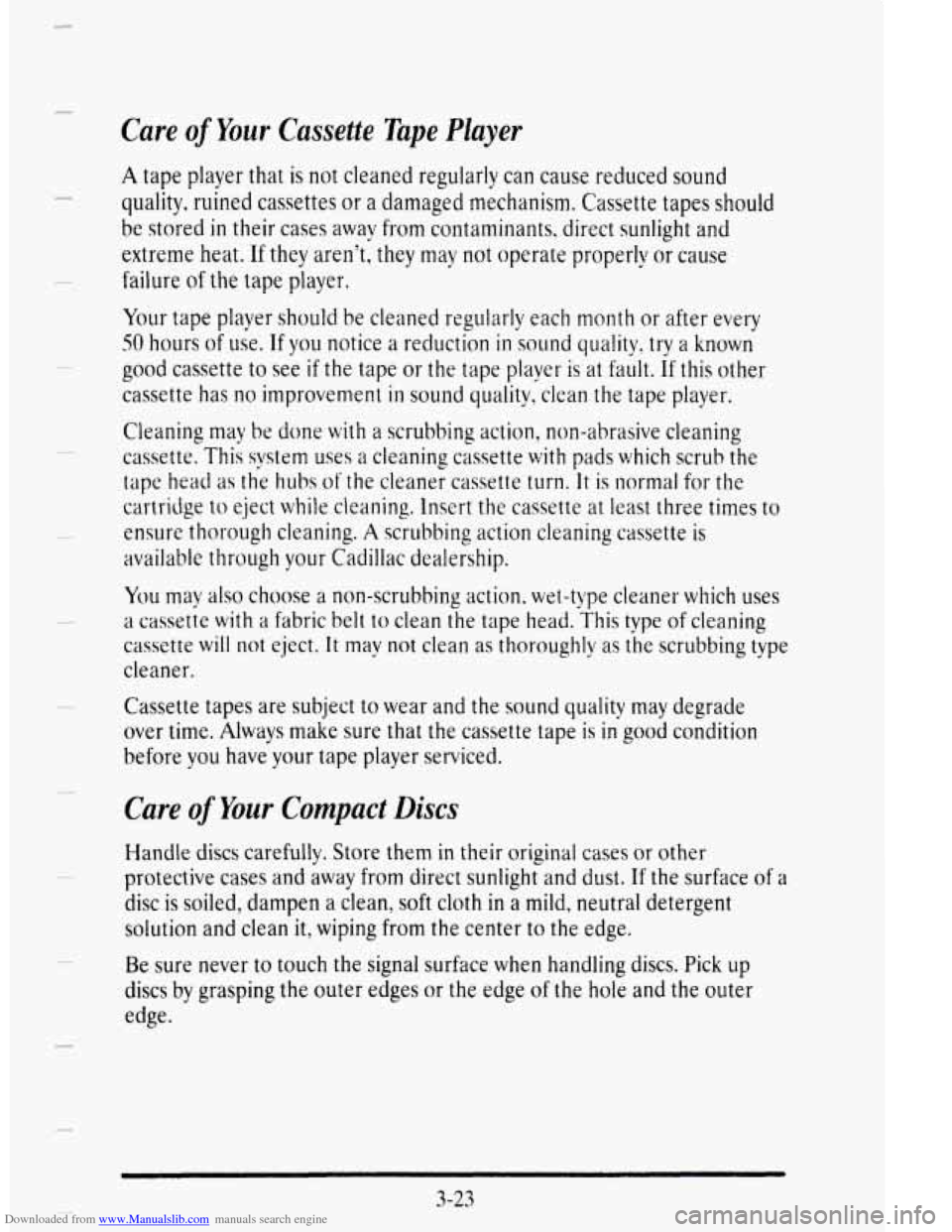
Downloaded from www.Manualslib.com manuals search engine Care of Your Cassette Tape Player
A tape player that is not cleaned regularly can cause reduced sound
quality,
ruined cassettes or a damaged mechanism. Cassette tapes should
be stored in their cases away from contaminants, direct sunlight and
extreme
heat. If they aren’t, they may not operate properly or cause
failure of the tape player.
Your tape plaver should be cleaned regularly each month
or after every
SO hours of &e. If you notice a reduction in sound quality, try a known
good cassette to see if the tape or the tape player is at fault. If this other
cassette bas no improvement
in sound quality, clean the tape player.
Cleaning may
be done with a scrubbing action, non-abrasive cleaning
cassette.’This system uses a cleaning cassette
with pads which scrub the
tape head
as the hubs of the cleaner cassette turn. It is normal for the
cartridge to eject while cleaning. Insert the cassette
at least three times to
ensure thorough cleaning. A scrubbing action cleaning cassette is
available tllrough your Cadillac dealership.
You ma!’ also choose a nan-scrubbing action. wet-type cleaner which uses
a cassetie with a fabric belt to clean the tape head.This tvpe of cleaning
cassette
will not e-iect. It may not clean as thoroughly as the scrubbing type
cleaner.
Cassette tapes are subject to wear and
the sound quality may degrade
over time. Always
make sure that the cassette tape is in good condition
before you have your tape player serviced.
Care of Your Compact Discs
Handle discs carefully. Store them in their original cases or other
protective cases and away from direct sunlight and dust. If the surface of
a
disc is soiled, dampen a clean, soft cloth in a mild, neutral detergent
solution and clean it, wiping from the center to the edge.
Be sure never to touch the signal surface when handling discs. Pick up
discs by grasping the outer edges or the edge of the hole and the outer
edge.
3-23
Page 200 of 403

Downloaded from www.Manualslib.com manuals search engine 4nti-Lock Brakes (ABS)
Your Cadillac has an advanced electronic braking system that will help
)revent a braking skid.
This light on the
instrunlent panel will
come on briefiy when
you start your vehicle.
LOCK (!I
ANTI-
When you start your vshiclc and begin to drive away, you may hear a
momentaw motor or cliclcing noise. And you may even notic; that your
brake pedal nloves a little while this is going on. This is the ABS system
testing itself. If there‘s a problem with the anti-lock brake system, the
anti-lock brake
system warning light will stay on.
See “Anti-Lock Brake System Warning Light” in the Index.
Here’s
how anti-lock works. Let‘s say the road is wet. You’re driving
safely. Suddenly an animal jumps out in front of you.
4-7
Page 206 of 403
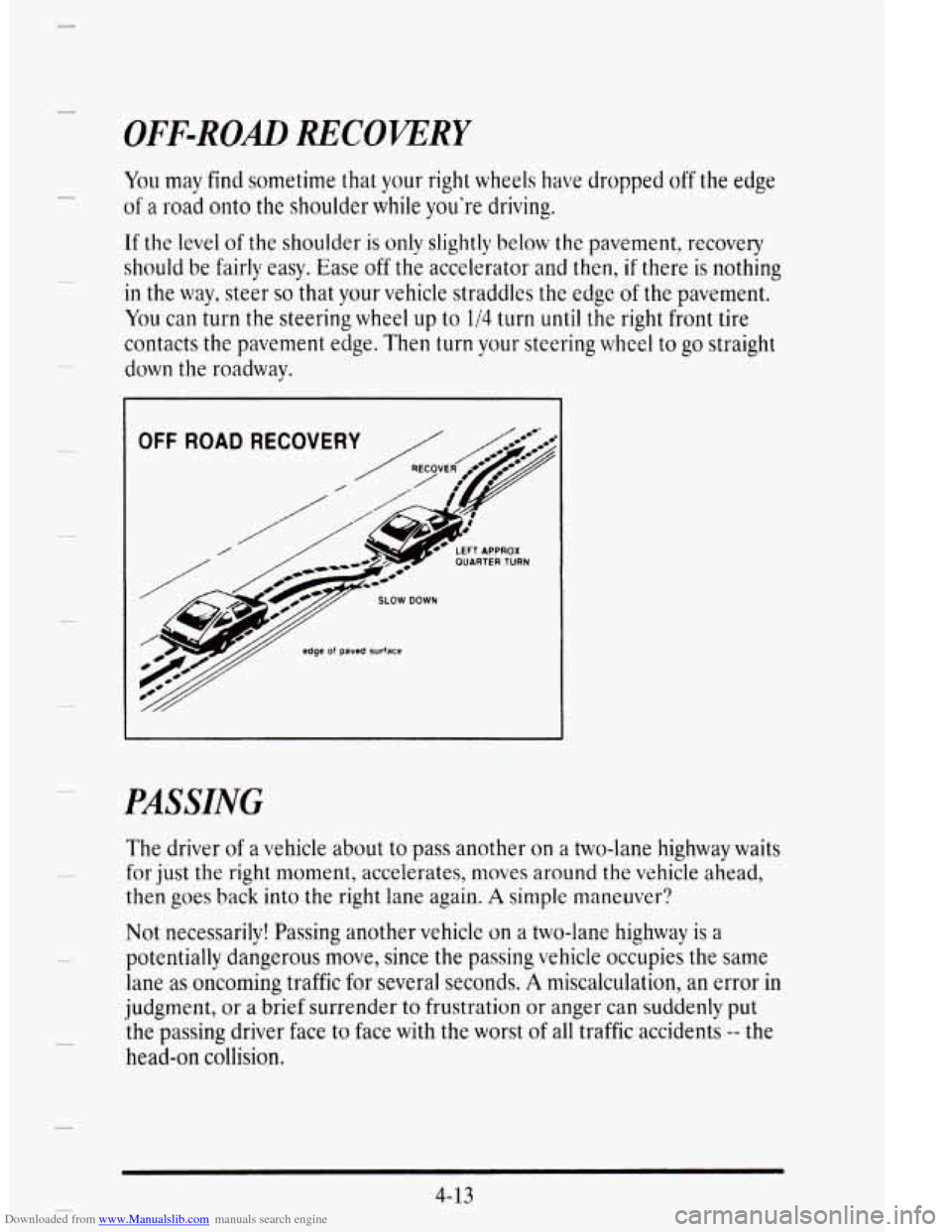
Downloaded from www.Manualslib.com manuals search engine OFF-ROAD RECOVERY
You mav find sometime that your right wheels have dropped off the edge
of a rmd onto the shoulder while you’re driving.
If the level of the shoulder is only slightly below the pave.ment, recovery
should
be fairly easy. Ease off the accelerator and then, if there is nothing
in the way, steer so that vour vehicle straddles the edge of the pavement.
You can turn the steering wheel up to 1/4 turn until the right front tire
contacts the pavement edge. Then turn your steering wheel to go straight
down the roadway.
PASSING
The driver of a vehicle about to pass another on a two-lane highway waits
for
just the right moment, accelerates, moves around the vehicle ahead,
then goes back into the right lane again. A simple maneuver?
Not necessarily! Passing another vehicle on a two-lane highway is a
potentially dangerous move, since the passing vehicle occupies the same
lane
as oncoming traffic for several seconds. A miscalculation, an error in
judgment, or a brief surrender to frustration or anger can suddenly put
the passing driver face to face with the worst of all traffic accidents -- the
head-on collision.
4-13
Page 210 of 403
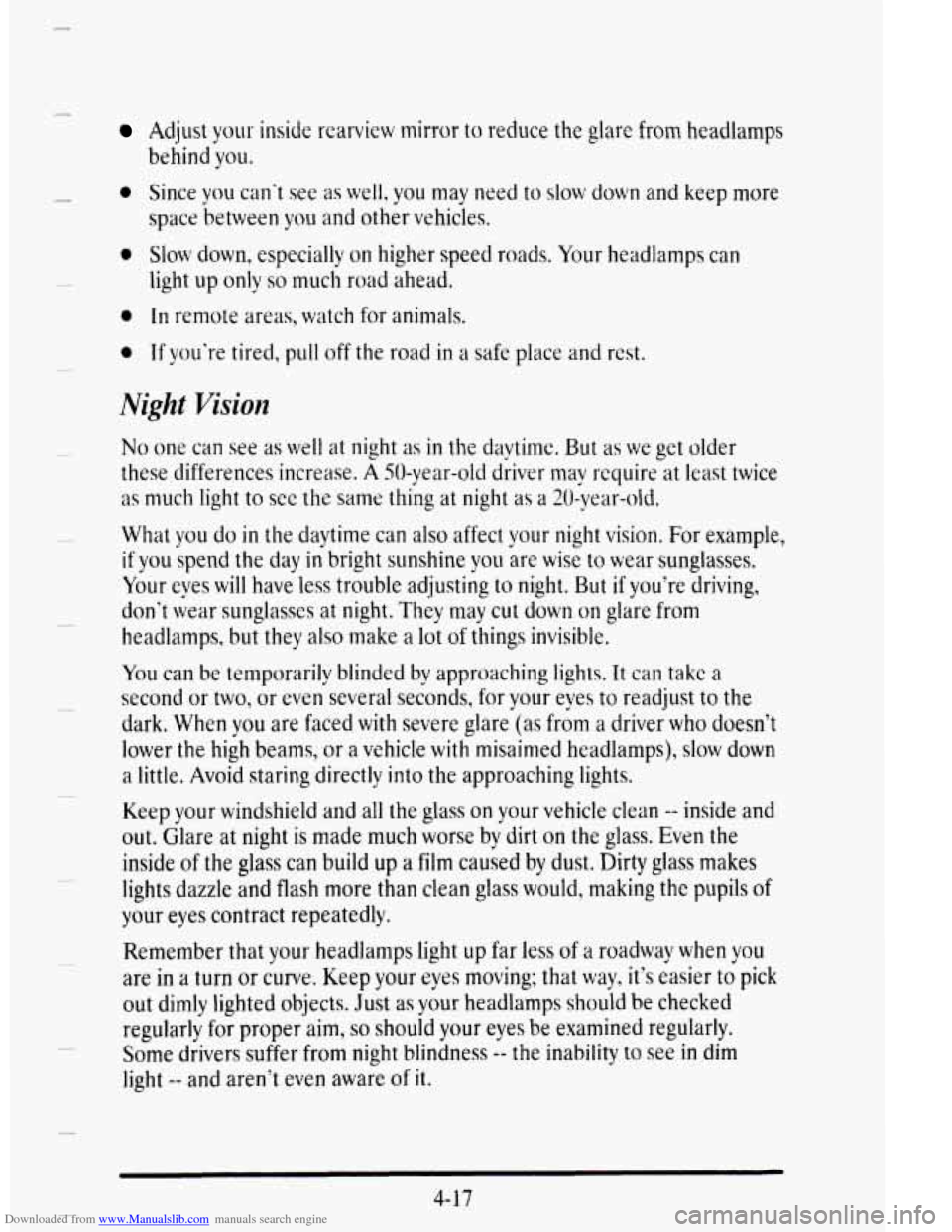
Downloaded from www.Manualslib.com manuals search engine 0
0 0
0
Adjust your inside rearview mirror to reduce the glare from headlamps
behind you.
Since you can‘t see
as well, you may need to slow down and keep more
space between
you and other vehicles.
Slow down, especially on higher speed roads. Your headlamps can
light up only
so much road ahead.
In remote areas, watch for animals.
If you’re tired, pull off the road in a safe place and rest.
Night Vision
No one can see as well at night as in the daytime. But as we get older
these differences increase. A 50-year-old driver may require at least twice
as much light to see the same thing at night as a 20-year-old.
What
you do in the daytime can also affect your night vision. For example,
if you spend the day in bright sunshine you are wise to wear sunglasses.
Your eyes
will have less trouble adjusting to night. But if you’re driving,
don’t wear sunglasses at night. They may cut down on glare from
headlamps, but they also make a lot of things invisible.
You can be temporarily blinded
bv approaching lights. It can take a
second or two, or even several seconds, for your eves to readjust to the
dark. When
YOU are faced with severe glare (as frim a driver who doesn’t
lower the
high beams, or a vehicle with misaimed headlamps), slow down
a little. Avoid staring directly into the approaching lights.
Keep
your windshield and all the glass on your vehicle clean -- inside and
out. Glare at night is made much worse
by dirt on the glass. Even the
inside
of the glass can build up a film caused by dust. Dirty glass makes
lights dazzle and flash more than clean glass would, making the pupils of
your eyes contract repeatedly.
Remember that your headlamps light up far
less of a roadway when you
are in a turn or curve. Keep your eyes moving; that way, it’s easier to pick
out dimly lighted objects. Just as
your headlamps should be checked
regularly for proper aim,
so should your eyes be examined regularly.
Some drivers suffer
from night blindness -- the inability to see in dim
light
-- and aren’t even aware of it.
4- 3.7
Page 214 of 403

Downloaded from www.Manualslib.com manuals search engine CITYDRIVING
P
r I
P I
r
One of the biggest problems with city streets is the amount of traffic on
them. You’ll want to watch out for what the other drivers are doing and
pay attention to traffic signals.
Here are ways to increase your safety
in city driving:
0
F
i
a
a
Know the best way to get to where you are going. Gct a city map and
pian your trip into an unknown part
of the city just as you would for a
cross-country trip.
Try to use the freeways that rim and crisscross most large cities. You’ll
save time and energy. (See the next part, “Freeway Driving.”)
Treat
a green light as a warning signal. A traffic light is there because
the corner
is busy enough to need it. When a light turns green, and just
before you start to move, check both ways for vehicles that have
not
cleared the intersection or may be running the red light.
P
4-21
Page 216 of 403

Downloaded from www.Manualslib.com manuals search engine Once you are moving on the freeway, make certain you allow a reasonable
following distance. Expect
to move slightly slower at night.
When
you want to leave the freeway, move to the proper lane well in
advance. If vou miss your exit do not, under any circumstances, stop and
back
up. Dr& on tolthe ncst exit.
The exit
ramp can be cuwed, sometimes quite sharply.
The exit
speed is usually posted.
BEFORE LEAUNG ON A LONG TRIP
Make sure vou're ready. Try to be well rested. If vou must start when
you're not iresh -- such as aftcr a day's work -- d6n.t plan to make too
many miles that first part of the journey. Wear comfortable clothing and
shoes
you can easily driw in.
Is vour vehicle ready for a long trip'! If you keep it stlnliced and
miintained, it's ready
to go. If it needs service, have it done before
starting
out. Of course, you'll find experienced and able service experts in
Cadillac dealerships all across North America. They'll be ready and
willing
to help if you need it.
Here are some things you can check before a trip:
Wirdd1ield Woslter Fluid: Is the reservoir full'? Are all windows clean
inside
and outside?
Tires: They are vitally important to a safe, trouble-free trip, Is the tread
good enough for long-distancc driving? Are thc tires all inflated to the
recornnxnded pressure'?
Should you
delay your trip a short time to avoid a major storm system'?
Weather Fomusts: What's the weather outlook along your route?
Mcq~s: Do you have up-to-date maps?
4-23
Page 220 of 403
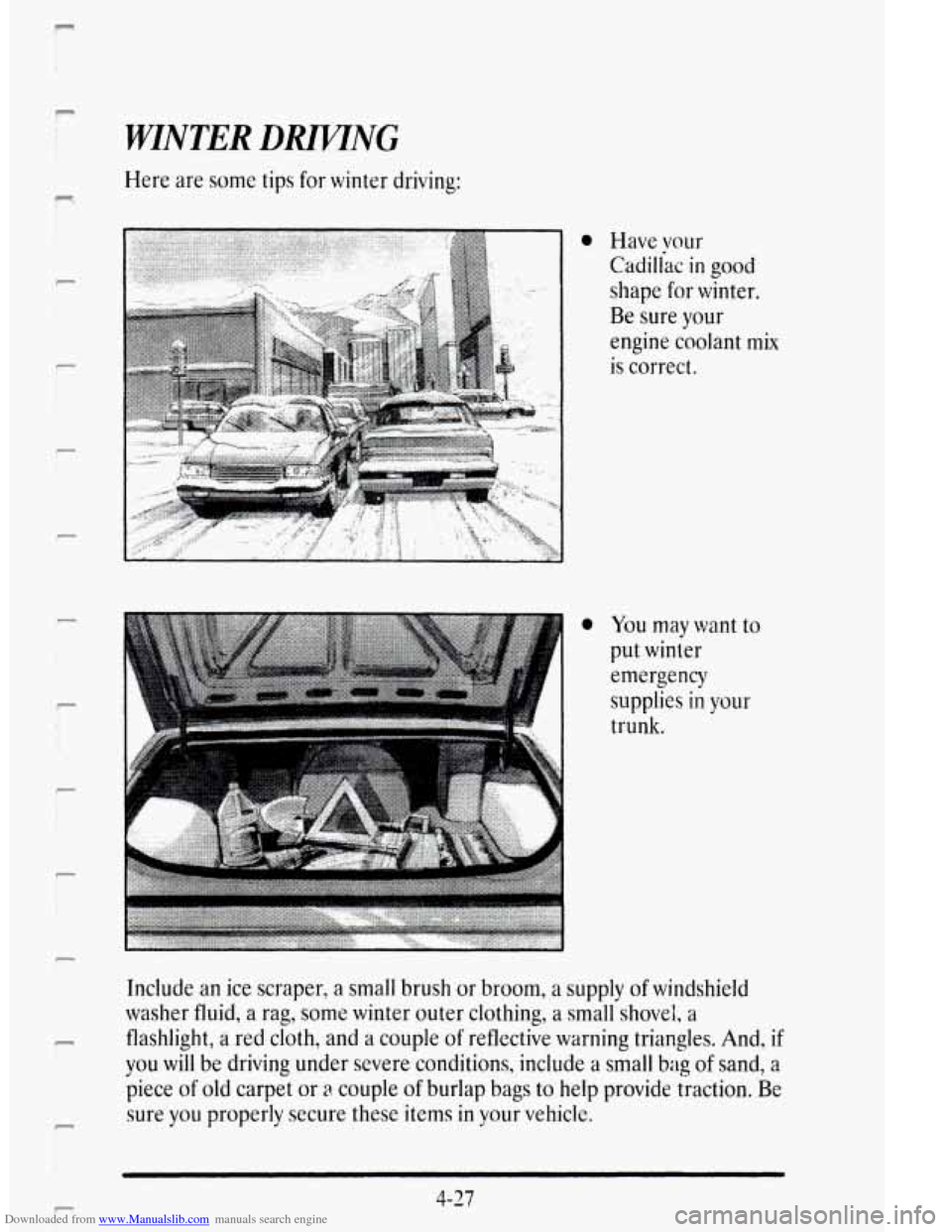
Downloaded from www.Manualslib.com manuals search engine c
n
P
P
r-
i
c
r
I !
f-
WINTER DWNG
Here are some tips for winter driving:
a Have vour
Cadiliac in good
shape for winter.
Be sure your
engine coolant
mix
is correct.
You may want to
put winter
emergency
supplies
in your
trunk.
Include an ice scraper, a
small brush or broom, a supply of windshield
washer fluid,
a rag, some winter outer clothing, a small shovel, a
flashlight, a red cloth, and a couple of reflective warning triangles. And, if
you will be driving under severe conditions, include a small bag of sand, a
piece
of old carpet or a couple of burlap bags to help provide traction. Be
sure
you properly secure these items in your vehicle.
F
4-27
Page 224 of 403
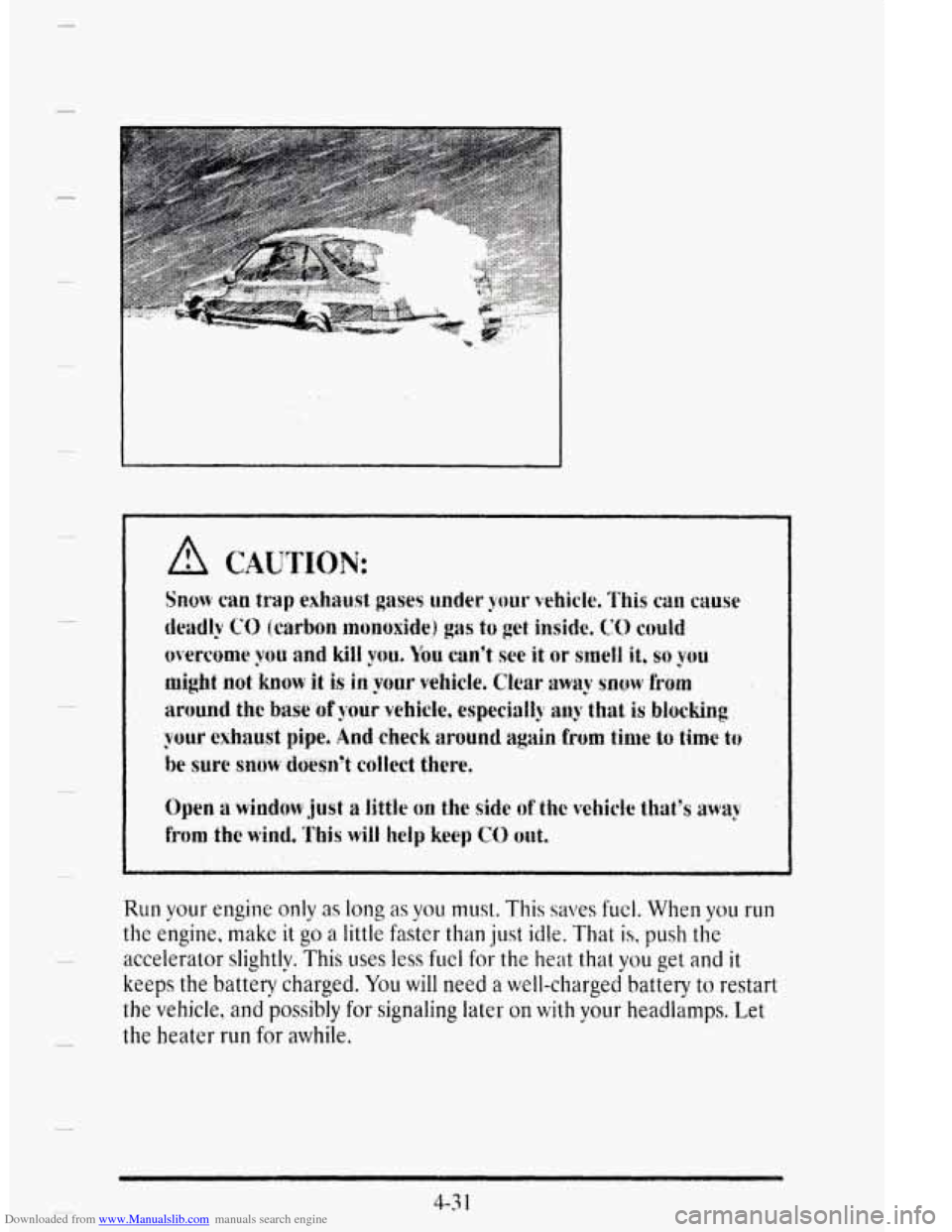
Downloaded from www.Manualslib.com manuals search engine c
. ... . . . . . , . .
:. . .
Run your engine only as long as you must. This saves fuel. When vou run
the engine, make it go a little faster than just idle. That is, push the
accelerator slightlv. This uses less fuel for the heat that you get and it
keeps the battew charged. You will need a well-charged battery to restart
the vehicle, and
possibly for signaling later on with your headlamps. Let
the heater run for awhile.
4-3 1
Page 232 of 403
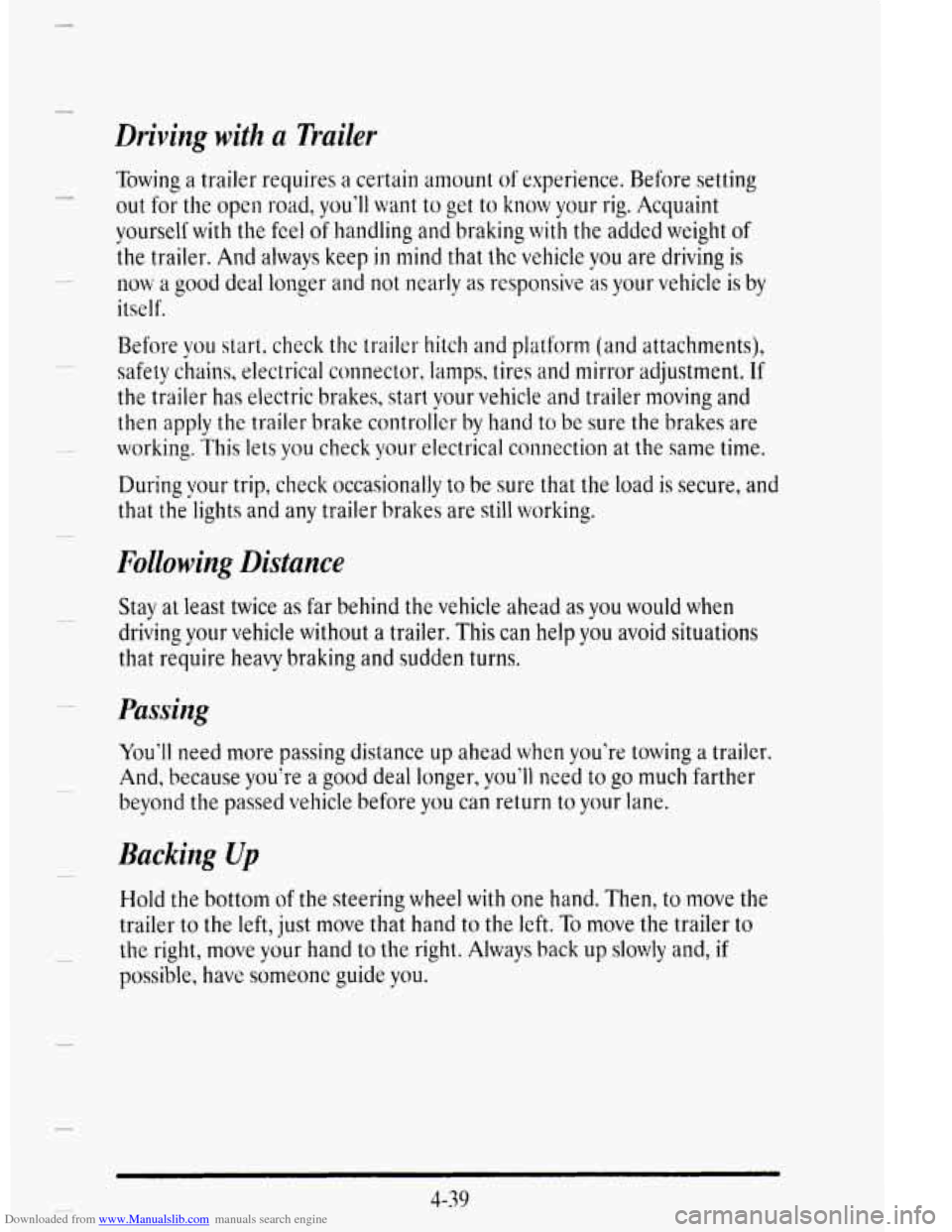
Downloaded from www.Manualslib.com manuals search engine Driving with a Trailer
Towing a trailer requires a certain amount of experience. Before setting
out for the open road, you’ll want to get to know your rig. Acquaint
yourself
with the feel of Ilandling and braking with the added weight of
the trailer. And always keep in mind that thc vehicle you are driving is
now a good deal longer and not nearly as responsivs as your vehicle is by
itself.
Before you start, check thc trailer hitch
and platform (and attachments),
safety chains, electrical connector, lamps, tires
and mirror adjustment. If
the trailer has electric brakes, start your vehicle and trailer moving and
then apply the trailer brake controlier by hand
to be sure the brakes are
working.
This lets you check your electrical connection at the same time.
During \Tour trip, check occasionally to
be sure that the load is secure, and
that the’lights and any trailer brakes are still working.
Following Distance
Stay at least twice as far behind the vehicle ahead as you would when
driving your vehicle without a trailer. This can help
you avoid situations
that require heavy braking and sudden turns.
Passing
You’ll need more passing distance up ahead when you’re towing a trailer.
And, because you‘re a good deal longer,
you’ll need to go much farther
beyond
the passed vehicle before you can return to your lane.
Bucking Up
Hold the bottom of the steering wheel with one hand. Then, to move the
trailer
to the left, just move that hand to the left. To move the trailer to
the right, move your hand to the right. Always back up slowly and, if
possible, havc someone guide you.
4-39